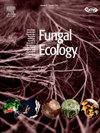The effects of tree diversity and neighborhood on phyllosphere fungal communities
IF 2.2
3区 环境科学与生态学
Q3 ECOLOGY
引用次数: 0
Abstract
Phyllosphere fungi, encompassing both epiphytic and endophytic fungi, have rarely been studied along gradients of host diversity. In this study, we used a tree biodiversity experiment to investigate how tree species richness, host and neighboring species identities, and host-mycorrhizal association affect the richness and composition of the whole phyllosphere community as well as that considering epiphytes and endophytes separately. To distinguish epiphytes from endophytes, we employed a leaf-surface sterilization treatment. Richness and composition of the mycobiome were quantified using next-generation amplicon sequencing. Our findings revealed that tree species richness affected only the overall phyllosphere fungal community, not endophytes alone, suggesting that neighborhood effects predominantly influence fungi on the leaf cuticle. Neighborhood effects were only detectable in the phyllosphere as a whole and not within endophyte and epiphyte communities. Fungal community composition was shaped by host species identity, tree richness, host mycorrhizal type and the combination of mycorrhizal types at the plot level. This study underlines the importance of analyzing epiphytes and endophytes separately and highlights the necessity of using leaf-surface sterilization when examining phyllosphere fungal communities.
树木多样性和邻域对层球真菌群落的影响
层球真菌包括附生真菌和内生真菌,很少沿着寄主多样性梯度进行研究。在本研究中,我们通过树木生物多样性实验研究了树种丰富度、寄主和邻近物种身份以及寄主-菌根关联如何影响整个层圈群落的丰富度和组成,以及分别考虑附生和内生真菌的影响。为了区分附生植物和内生植物,我们采用了叶片表面灭菌处理。利用新一代扩增子测序对真菌群落的丰富度和组成进行了量化。研究结果表明,树木物种丰富度仅影响整个叶层真菌群落,而不仅仅是内生真菌,这表明邻域效应主要影响叶角质层真菌。邻域效应仅在整个层层中存在,而在内生菌和附生菌群落中不存在。在样地水平上,真菌群落组成受寄主物种身份、树木丰富度、寄主菌根类型和菌根类型组合的影响。本研究强调了分别分析附生菌和内生菌的重要性,并强调了在检测层球真菌群落时使用叶表面灭菌的必要性。
本文章由计算机程序翻译,如有差异,请以英文原文为准。
求助全文
约1分钟内获得全文
求助全文
来源期刊

Fungal Ecology
环境科学-生态学
CiteScore
5.80
自引率
3.40%
发文量
51
审稿时长
3 months
期刊介绍:
Fungal Ecology publishes investigations into all aspects of fungal ecology, including the following (not exclusive): population dynamics; adaptation; evolution; role in ecosystem functioning, nutrient cycling, decomposition, carbon allocation; ecophysiology; intra- and inter-specific mycelial interactions, fungus-plant (pathogens, mycorrhizas, lichens, endophytes), fungus-invertebrate and fungus-microbe interaction; genomics and (evolutionary) genetics; conservation and biodiversity; remote sensing; bioremediation and biodegradation; quantitative and computational aspects - modelling, indicators, complexity, informatics. The usual prerequisites for publication will be originality, clarity, and significance as relevant to a better understanding of the ecology of fungi.
 求助内容:
求助内容: 应助结果提醒方式:
应助结果提醒方式:


